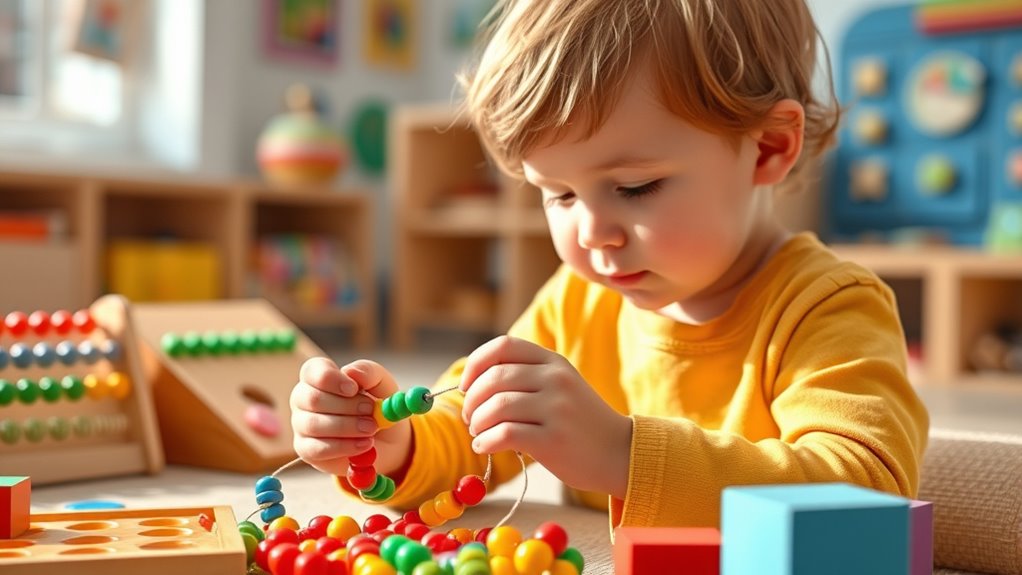To boost your preschooler’s dexterity, choose toys like puzzles with small pieces, building blocks, and stacking toys that improve hand-eye coordination and finger strength. Activities like threading beads, playing with playdough, or using tweezers to pick up small objects also strengthen fine motor skills. Incorporating drawing, coloring, and craft supplies keeps things fun and engaging. Keep exploring ways to support their development—there’s plenty more to discover.
Key Takeaways
- Puzzles with small pieces enhance hand-eye coordination and problem-solving skills in preschoolers.
- Building blocks and stacking toys develop grasping, finger strength, and fine motor control.
- Bead threading kits and small object transfer activities strengthen pincer grasp and dexterity.
- Manipulative toys like tweezers and textured materials improve delicate touch and coordination.
- Drawing, coloring, and craft kits with stencils or stickers foster precision and creative motor skills.

Fine motor skills refer to the small movements your hands and fingers make, which are essential for everyday tasks like writing, buttoning a shirt, or using utensils. As a parent or caregiver, you want to support your preschooler’s development by engaging them in beneficial activities that promote these skills. These activities help children reach important developmental milestones, such as improved hand-eye coordination, finger strength, and dexterity. When you encourage your child to participate in targeted play, you’re helping them refine their motor control, which will serve as a foundation for more complex tasks later on.
Supporting your preschooler’s development with engaging activities enhances their fine motor skills and prepares them for future tasks.
One way to boost fine motor development is by introducing toys that challenge their dexterity. Puzzles with small pieces, for example, require children to grasp, manipulate, and fit pieces into the correct spots. This not only improves their hand-eye coordination but also helps develop patience and problem-solving skills. Similarly, building blocks or stacking toys teach children to grasp objects carefully and coordinate their movements to create structures. These activities are beneficial because they mimic real-life tasks and foster a sense of accomplishment as your child successfully completes each project.
Drawing, coloring, and writing activities are also excellent choices. You can encourage your preschooler to use crayons, markers, or pencils to draw shapes, scribble, or copy simple letters. These activities strengthen finger muscles and improve control over hand movements. To make it more engaging, consider offering stencils, stickers, or textured papers, which add variety and challenge your child to use different grips and movements. Over time, these exercises support the developmental milestones of improved grip, precision, and coordination needed for writing.
In addition, activities like threading beads, playing with playdough, or using tweezers to pick up small objects are highly beneficial. These tasks require a delicate touch and help develop pincer grasp—the ability to hold objects between the thumb and forefinger—which is a key milestone in fine motor development. You can create fun, simple challenges such as threading pasta onto string or transferring small items from one container to another. These playful tasks keep your child engaged while building strength and coordination in their fingers and hands.
Frequently Asked Questions
How Can I Encourage My Preschooler to Develop Fine Motor Skills?
To encourage your preschooler to develop fine motor skills, focus on engaging them in play-based activities that involve their hands and fingers. Incorporate sensory play, like playing with clay or finger paints, which helps improve dexterity. Offer a variety of toys that promote grasping, pinching, and threading. By making these activities fun and interactive, you’ll help strengthen their fine motor skills and boost their confidence in using their hands.
What Are Signs of Delayed Fine Motor Development in Preschoolers?
You might notice signs of delayed fine motor development if your preschooler struggles with hand-eye coordination or has an awkward pencil grasp. They may have difficulty completing tasks like zipping or buttoning, or show less interest in activities requiring precise movements. If their hand movements seem uncoordinated or they avoid drawing or writing, it could indicate a delay. Early intervention can help improve these skills effectively.
Are There Specific Toys Recommended for Different Age Groups?
You might find it interesting that choosing age-appropriate toys aligns with your child’s developmental milestones. For preschoolers, toys like chunky puzzles, lacing beads, and building blocks help develop fine motor skills. As they grow, more complex activities like zip-up dolls or scissors encourage dexterity. By selecting toys suited to their age, you support their growth and make sure they stay engaged while reaching key milestones in their fine motor development.
How Much Time Should Preschoolers Spend on Fine Motor Activities Daily?
You should aim for preschoolers to spend about 20-30 minutes daily on age-appropriate activities that promote fine motor skills. Incorporate play-based learning to keep them engaged and make skill development fun. Break this time into short sessions, mixing activities like drawing, stringing beads, or cutting with scissors. Consistent practice helps improve dexterity, coordination, and hand-eye skills while keeping the experience enjoyable for your child.
Can Fine Motor Skill Development Improve Handwriting Skills?
Yes, improving fine motor skills can markedly enhance handwriting. When you focus on activities that develop fine motor precision, your preschooler gains better control and coordination, leading to clearer, more legible handwriting. Consistent practice helps strengthen small muscles in their hands, making writing easier and more comfortable. By encouraging fine motor development, you set a strong foundation for future handwriting improvement and overall academic success.
Conclusion
By choosing toys that encourage grasping, pinching, and manipulating, you help boost your preschooler’s fine motor skills. By providing activities that challenge their dexterity, you support their development and confidence. By offering engaging, age-appropriate toys, you foster independence and creativity. By making play fun and purposeful, you set the foundation for future learning. By nurturing their skills today, you prepare them for tomorrow’s tasks—building a brighter, more capable future, one toy at a time.










